|
the Falklands War

The Frigate HMS Antelope explodes after a bomb 'cooks' amidships
The first RAF mission
after the Argentine invasion was a reconnaissance sortie flown by a Nimrod
MR1 of No.42 squadron from Ascension Island which surveyed the Argentine
forces on and around the Islands in support of the submarines deploying
ahead of the main task force. These mission continued until 15th April
when No.42 was relived by Nimrod MR2s, some armed with self defence
Sidewinder missiles from the Kinloss wing.
On the 21st April, Sea
Harriers of No.800 Squadron intercepted an Argentine Air Force Boeing 707
carrying out a reconnaissance over the task force, it was escorted out of
the area. Four days later British Forces recaptured South Georgia and a
Royal Navy Wasp damaged the Argentine Submarine Sante Fe with AS12
missiles.
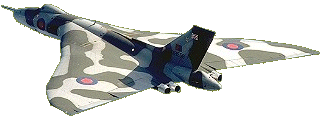
On 30th April, A Vulcan
bombed Stanley airfield in the first of the Black Buck raids. Three
Vulcans, drawn from Nos. 44 and 50 Squadron then on the verge of
retirement, were deployed to Ascension and from there one flew 3,500 miles
- with airborne refuelling - to drop twenty one 1,000lb bombs on the
runway from 8,000ft at 0438 hours local time before returning to
Ascension. It had been refuelled 17 times en route by Victor tankers and
was airborne for 15 hours 45 minutes to complete the longest bombing
mission on record at that time. The following dawn, Sea Harriers attacked
the airfield at low level. One of the Harriers was damaged by ground fire.
Pictured right is a Vulcan courtesy of Edd Draper from his
Royal Air Force site.

The following day, the
Argentine Cruiser was spotted by Canberra PR9s of No.39 Squadron operating
clandestinely out of Chile, and subsequently sank by H.M.S. Conqueror.
meanwhile the Task Force entered the 300 mile Total Exclusion Zone around
the Islands and attacked the airfield with naval gunfire. On the night of
3rd May, the Vulcans made a second 'Black Buck' raid on Port Stanley.
The 4th May saw H.M.S.
Sheffield hit by an Argentine Exocet missile, she subsequently sank. The
same day, the first Sea Harrier was lost to enemy ground fire. Meanwhile,
nine Harrier GR3s from No.1 Squadron from the Uk to Ascension in 9 hours
and 15 minutes, having been adapted to carry Sidewinders and naval 2 inch
rockets. Two days later, the Task Force lost two Sea Harriers when they
failed to return from a Cap and are presumed to have collided in bad
weather.
Summary of Main Events - 10th-16th May
1982
|
 |
CVBG - CV Hermes, Invincible; DD
Glamorgan, Coventry, Glasgow; FR Alacrity, Arrow, Brilliant,
Broadsword, Yarmouth; RFA Fort Austin, Olmeda, Resource; with SBS
and SAS
1. SHEFFIELD sinks (10th)
2. Alacrity enters Falkland Sound from the south (10th)
3. Alacrity sinks Isla de los Estados off Swan Is (10th/11th)
4. Alacrity meets Arrow and heads back to CVBG (10th/11th)
5. Glasgow damaged off Stanley/ 5. Argentine aircraft lost -
[a16,a17,a18] Skyhawks (12th)
6. Argentine aircraft lost at Goose Green - [a19] Skyhawk (12th)
7. PEBBLE ISLAND OPERATION (11th-15th) (1) SAS Boat Troop patrol
ashore to reconnoitre (11th/12th) (2) Hermes, Broadsword and
Glamorgan approach and D Sqdn SAS landed by No.846 Sea Kings (14th)
8. Pebble Island Installations and aircraft destroyed and force
returns to CVBG; Argentine aircraft lost - [a20-25] Pucaras,
[a26-29] Mentors, [a30] Skyvan (14th/15th)
9. British aircraft lost east of Falklands - [b7] Sea King (12th)
10. Argentine cargo ship Rio Carcarana attacked and beached in Port
King (16th)
11. Argentine transport Bahia Buen Suceso damaged at Fox Bay East
(16th)
|
|
The 7th May saw Britain
extend the TEZ to within 12 miles of the Argentine coast and two days
later an Argentine surveillance trawler was found within the TEZ and
strafed by Sea Harriers, and sunk after the crew surrendered. A period of
bad weather followed restricting flying for both sides, although the SAS
destroyed a number of Argentine aircraft on the ground at the Pebble
Island airstrip during the night of
14/15th May.
The following day two Sea
Harriers strafed Argentine supply vessels in Falkland Sound, damaging one
so badly that it had to be beached. The 18th May, saw the RAF Harriers
from Ascension arrive onboard the freighter Atlantic Conveyor, from where
they transferred to the H.M.S. Hermes, the following day three of them
dropped cluster bombs on a fuel dump near Fox bay. The main amphibious
landing took place on 21st May, with the Harriers providing air defence
and ground support. The Frigate H.M.S. Ardent was destroyed by rocket fire
from Argentine aircraft, but the Harriers accounted for three Skyhawk and
three Daggers with Sidewinder Air-to-air missiles and another two Pucaras
with gunfire. Two pumas and a Chinook were destroyed on the ground in the
mount Kent area. one Harrier was shot down by ground fire and its pilot
captured.
More ground support
sorties were flown on the 23rd, including bombings of airstrips at Dunnose
Head and Pebble Beach, destroying a number of Pucaras. H.M.S. Antelope was
crippled by A-4 Skyhawks in San Carlos water the same day. The next day
saw Sea Harriers and RAF Harriers dropped 1,000lb bombs, managed to damage
a number of aircraft despite exceptionally heavy fire. A Sea Harrier was
lost when it crashed into the sea, killing its pilot. While Sea Harriers
accounted for a Mirage and three Daggers. The following day, the Skyhawks
were back in force, sinking H.M.S. Coventry. Argentine Super Etendards
launched Exocet missiles which set fire to the Atlantic Conveyor and
caused her to be abandoned later along with her precious cargo of
Chinooks. Harriers destroyed an Argentine Puma near Douglas settlement
using cluster bombs. Harrier raids on the airfields were repeated the next
day and again on the 27th. Another Harrier was downed during the 27th,
again by ground fire. the pilot was rescued.

Sea Harriers of No.801 NAS.
Starting with just 20 Sea Harriers, a further eight joined the Task Force
by mid-May. A total of six were lost by accident or ground fire, and not
one in air-to-air combat
The 28th saw three
Harriers support 2 Para and encouraged 1200 Argentine troops to surrender
on the following morning. The 30th May was marked by Harriers mounting 10
close support sorties, one used Laser Guided Bombs, although they were
ineffective due to the failure of the Forward Air Controller to be in the
correct position. A third Harrier was lost to ground fire, but the pilot
was plucked form the sea within minutes by a helicopters. A third Black
Buck mission hit Stanley Airfield that night, the Vulcan being armed with
American Shrike missiles, which temporarily disabled the radar. Meanwhile,
Argentine Canberras bombed troop positions at San Carlos with little
success. The 1st June was opened with a series of raids on Stanley
airfield, but a pair of Harriers failed to intercept some MB339s reported
in the area. However, two Harriers of No.801 squadron attacked an
Argentine Hercules and shot it down, a similar aircraft (if not the very
same aircraft) was reported to have bombed a British Tanker two days
previously.

Sea Harriers of No 800 NAS aboard HMS Hermes in "typical foul weather" in
the Atlantic during winter. Probably taken post-war, but typical of South
Atlantic conditions during the Falkland's War
A Second Black Buck
anti-radar sortie was mounted on the night of 2/3 June, but failed because
the Argentineans shut the radar down. The Vulcan was forced to land in
Brazil and was impounded until the 11th June following damage to its
refuelling probe. The remaining missile was confiscated. Bad weather again
intervened until the 5th June
The next sorties were on
5th June, when Harriers flew eight close support and armed recce sorties
in search of ground-based Exocets. On the same day, the San Carlos
prefabricated airstrip went into operation. A Harrier was damaged by a
near-miss with a Surface to Air Missile and landed roughly at the
prefabricated airstrip. Heavy Argentine air activity provided the Sea
Harriers with plenty of chance for Target practice on the 8th June, when
they downed three Skyhawks. However, four others got through and bombed
the troopships Sir Galahad and Sir Tristram, leaving 53 dead. Two more
Harriers had arrived during the day, following a 3,500 mile flight.
Another tanker was bombed by an Argentinean Hercules on the 12th June, but
the bombs failed to explode. More close support sorties followed for the
next few days, including the last Black Buck mission on the night of 12/13
June, with 1,000lb bombs.
The 13th June saw the
first successful Laser Guided Bomb sorties against an enemy 155 mm gun,
which was destroyed at Mount Tumbleweed. A similar sorties the following
day was called off when negotiations began.
On the 14th July 1982, the
Argentine troops surrendered. During the eight week conflict 28 Sea
Harriers flew 1,435 operational sorties shooting down 20 enemy aircraft
plus three probables, while 14 Harriers flew a total of 126 sorties and
the Vulcans five. They were supported by 375 Victor Tanker, 111 Nimrod and
more than 600 Hercules and VC10 sorties with countless helicopter
missions.
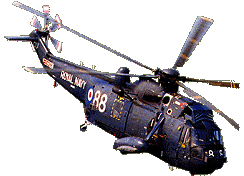
Helicopters
in the Falklands War
When Argentina invaded the
Falklands Islands and South Georgia on Friday, 2nd April 1982 a British
task Force sailed within 72 hours comprised of H.M.S. Hermes and H.M.S.
Invincible both carriers were equipped with the Harrier V/STOL fighter and
Westland Sea King helicopters. Some of their escort vessels were carrying
the Westland Lynx HAS Mk I or Westland Scouts and Wasps. The task force
carried a sizeable detachment of Royal Marines and British Army units. The
flexibility of the helicopter and harrier was what made the recapture of
the Falkland Islands possible. The Task force also included the two
assault ships H.M.S. Fearless and Intrepid, and several requisitioned
merchant ships acting as troops transports and the Atlantic Conveyor which
was employed as a make-shift aircraft carrier, and helicopter landing
platforms were added to ships such as the Queen Elizabeth II, Canberra and
Uganda. RAF Boeing-Vertol Chinook and Westland-Aerospatiale Puma
helicopters were also carried.
Westland Wessex
helicopters inserted and took off an SAS patrol on South Georgia, despite
loosing two of their number in the appalling conditions. The pilot was
awarded the DSO for taking off from South Georgia in such appalling
conditions with a massive overload of seventeen soldiers and naval airmen
(Crew of the two previously crashed Wessexes). Later, SAS and SBS units
were transported by helicopter to take control of the principal settlement
on South Georgia, Gritvyken without a shot being fired, almost 200
Argentine soldiers were taken prisoner.
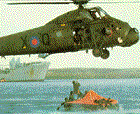
Throughout the Falklands
campaign the helicopter provided vital transport. Although several
helicopters were lost in accidents, very few were lost to enemy fire due
to the skill and courage of the pilots when faced with the Argentine Kfir,
Mirage and Skyhawk fighters. Whereas the Argentine forces lost two Pumas
and a bell UH-1 Iroquois to attack by Royal Navy Sea Harriers. The
Helicopter enabled just 600 men of 2 Para to take positions held by almost
2,000 Argentine troops, in a complete reversal of normal military doctrine
which calls for an attacking force of three or four times the number of
the defending one. Helicopters also evacuated casualties from the stricken
RFA Sir Tristram and Sir Galahad while both ships were burning, and their
ammunition 'cooking off'.
The lack of Airborne Early
Warning aircraft available to the British fleet following the scrapping of
the Royal navy's conventional aircraft carriers and the subsequent
sinkings of a number of Task Force ships convinced the Admiralty that such
an aircraft was needed and Royal Navy ASW Sea Kings were converted after
the war to serve this role.
The
war from Argentina's side
by Diego Zampini.
In September 1980, fifty
pilots and technician personnel of the 2ª Escuadrilla Aeronaval de Caza y
Ataque (2nd Air Naval Fighter and Strike Squadron) of the CANA (Comando de
Aviación Naval Argentina, Argentine Naval Aviation Command) arrived at
Rochefort Naval Base, in France. Among the group of pilots were the unit's
commander, Frigate Captain Jorge Colombo, and sub-commander, Corvette
Captain Augusto Bedacarratz. The rest of the pilots were: Corvette
Captains Roberto Agotegaray, Roberto Curilovic and Alejandro Francisco,
and Warship Lieutenants Luis Collavino, Julio Barrraza, Juan Rodriguez
Mariani, Armando Mayora and Carlos Machetanz. All the pilots had hundreds
of hours flying A-4Q Skyhawks (the main type of combat plane used by the
CANA by that time).
After three months of
French language teaching, they were sent to Landivisiau Air Naval Base,
where they flew training sorties in Morane Saulnier planes during 30 days
and then began to know their future combat tool - the AMD-BA (Avions
Marcel Dassault - Breguet Aviation) Super Etendard. Later, the Argentine
pilots started to learn the basic flight lessons in the Super Etendard (a
maximum of 50 hours of flight by each pilot) and basic notions about the
weapon systems, especially the anti-ship missile AM.39 Exocet. The
technical specifications of them are:
AMD-BA Super Etendard:

-
Engine: turbojet SNECMA
Atar 8K-50 with a thrust of 5.000 kilograms.
-
Top speed at sea level:
1200 km/h.
-
Ceiling: 13,700 mts.
-
Range flying at sea
level: 720 kms.
-
Weapons: two 30 mm
cannons, and 2,270 kgs of weapons load (including bombs, air-to-air R.550
Magic missiles and anti-ship AM.39 Exocet missiles).
AM.39 Exocet
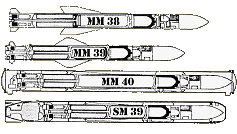
-
Type: airborne "fire and
forget" anti-ship missile.
-
Lenght: 5.20 meters.
-
Diameter: 35 centimetres.
-
Wingspan: 1 meter.
-
Weight: 655 kgs.
-
Range: 70 kms (35 miles)
Cruise speed: 1100 km/h (Mach 0.9)
-
Left: The Exocet family.
The SM.39 is the submarine launched version, while both the MM.38 and
MM.40 are the ship-to-ship versions. The last member of the family is the
AM.39; the air-to-ship version. This was the type of missile used by the
Argentine 2nd Air Naval Squadron.
To attack a ship with the
AM.39 version is a work of two stages: first, the missile is guided by the
plane's fire control system, which gives to the missile the target's
coordinates and these coordinates are obtained by the plane's radar. When
the missile is launched, it dives to an altitude of 30 meters, which is
later fixed at only 2.5 meters by the missile's radio altimeter. In the
few final seconds of flight, the missile activates its own radar and
searches for the target. If it finds any, the missile locks on to it and
guides itself to the impact point.
The Argentine pilots and
technicians returned to Comandante Espora Air Naval Base (Buenos Aires
Province, Argentina) in July 1981 and began the preparation for arrival of
the first five Super Etendards, which finally happened in November 1981.
The Argentine Navy had ordered a total number of 14 aircraft, and the same
number of Exocets. The Argentine pilots tested the navigation system of
the five planes as much as they could, and started to do the same with the
weapon system.
The
War Began
But on April 2nd 1982,
when the 2nd Squadron was waiting the arrival of the French technical team
to put the Exocets in an operational status, Argentina performed the
military re-conquest of the Falklands Islands - called Malvinas in Spanish
language - usurped by the British government in 1833. One of the first
acts of the French government was to declare a weapons embargo against
Argentina until the conflict ended.
Of course, it deprived the
2nd Squadron of the possibility of being assisted by French technicians
but the Argentine personnel of the unit, far from giving up, faced on
their own the challenge to set up the Exocets. Two weeks later, the
interface between airplane and missile had been solved, and the tests on
anti-ship strikes began. Fortunately for the Argentineans, the country had
bought from Great Britain two Type 42 destroyers (the same class used by
the Royal Navy), the ARA Hércules and ARA Santísima Trinidad. In
consequence, the unit's pilots tested and improved the attack tactics
against these kinds of ships.
On May 1st 1982, The RAF
and Royal Navy planes attacked the main Argentine airfields and positions
in the islands. The Argentine Navy organized a combined strike against the
British aircraft carriers: eight A-4Qs belonging to the 3rd Air Naval
Fighter and Strike Squadron on board the Argentine carrier, ARA
Veinticinco de Mayo, and two Super Etendards from Río Grande Air Naval
Base would attack at the same time on May 2nd. But that day both arms of
the attack had problems; the naval Skyhawks needed a minimum wind to help
them take off from the carrier, and unexpectedly the wind, normally strong
in the South Atlantic, did not blow. On the 2nd Squadron's side, both
Super Etendards, piloted by the unit commander, Jorge Colombo, and his
wingman Carlos Machetanz, were affected by problems that did not allow
them to receive fuel from the KC-130H Hercules tanker. Later that same day
the British submarine HMS Conqueror sunk the Argentine cruiser ARA General
Belgrano and forced the Argentine Sea Fleet to come back to Puerto
Belgrano Naval Base.

A photograph of a SP-2H Neptune On May 4th 1982 this type plane,
when piloted by Corvette Captain Ernesto Proni Leston, detected the
destroyer HMS Sheffield and gave her coordinates to the Super Etendards
armed with Exocets.
The End of
the HMS Sheffield
At 5:07 hrs on May 4th
1982, a SP-2H Neptune, serial number 0708/2-P-112, call sign 'Mercurio',
belonging to the Exploration Squadron of the CANA, took off from Río
Grande Air Naval Base. The plane's crew was composed of three members, and
the pilot was Corvette Captain Ernesto Proni Leston (the other members
were the copilot and Operative Control Officer, surnamed Pernussi).
Originally the mission was to detect any British naval activity to allow a
group of C-130s to land on Puerto Argentino's airport, but even when the
flight of the Hercules was aborted, the Neptune sortie stands. At 7:50 the
Neptune had his first radar contact with a British warship, and Proni
reported the news to the CANA. He was ordered to keep contact but with
discretion. 'Mercurio' had two other contacts at 8:14 and 8:43. A few
minutes later an order from the High Command of CANA arrived to evade any
contact until 10:00 hrs. Proni guessed that an Exocet sortie was on the
way, and set the Neptune's course to the area of the wreckage of the ARA
General Belgrano, pretending to be part of a rescue mission searching for
survivors.

This was the flight path followed by the Neptune of
Corvette Captain Proni Leston on May 4th 1982.
The news about Captain
Proni's findings arrived to Río Grande quickly, and it was the turn for
Corvette Captain Augusto César Bedacarratz and Frigate Lieutenat Armando
Mayora to fly the anti-ship sorties, and all the other pilots helped to
prepare the flight paths, points of meeting with the KC-130H tanker, etc.
Both Super Etendards took off from Río Grande at 9:45 hrs. Bedacarratz,
the leader, (call sign 'Aries') flew the plane 0752/3-A-202, and Mayora,
the wingman, (call sign 'Boina') did so with his plane 0753/3-A-203. At
10:00 hrs they met the KC-130H tanker provided by the FAA (Fuerza Aérea
Argentina - Argentine Air Force) piloted by Vicecommodore Pessana and
received all the necessary fuel to complete the mission.
At 10:35, Corvette Captain
Proni did his last climb at 1,170 meters (3,500 feet) and detected a big
contact and two medium-size in the coordinates 52º 33' 55'' South, 57º 40'
55'' West. A few minutes later he radioed both Super Etendards and gave
the information to Bedacarratz. After that, Proni set his course to Río
Grande and landed at 12:04 hrs. His long sortie had reached the end.
But the mission of the
SUEs (nickname given by the Argentine pilots to the Super Etendards) had
just begun. Flying at very low altitude, around 10:50 hrs they climbed at
160 meters (500 feet) to verify the coordinates given by Proni, but they
found... nothing! Both pilots turned back to searching and Bedacarratz
decided to continue. 40 kms (25 miles) later they climbed again and, after
a few seconds of scanning, the targets appeared on their radar screens.
Both pilots loaded the coordinates in their weapons systems, turned back
to low level, and after the last minute check, launched their AM.39
Exocets. The exact time was 11:04 hrs.
During the flight back to
the base, Bedacarratz realized that they would not need the KC-130H
assistance, and called to Vicecommodore Pessana declining the refuelling.
Pessano was then the first Argentine officer to know the success of the
mission. Bedacarratz and Mayora landed at 12:04 hrs, exactly an hour after
having launched the missiles. It is unnecessary to say that they were
received by their happy comrades as heroes.
Argentine pilots belonging to the 2nd Air
Naval Fighter
and Strike Squadron of the Argentine Navy.
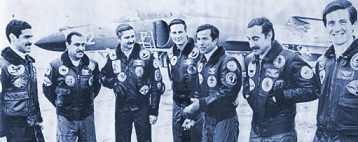
From left to right: Frigate Lieutenant Rodríguez Mariani, Corvette Captain
Curilovic (who participated in the May 25th sortie when the Atlantic
Conveyor was sunk), Frigate Captain Colombo (unit commander) , Corvette
Captain Agotegaray, Warship Lieutenant Francisco (who hit the British
carrier HMS Invincible on May 30th), Corvette Captain Bedacarratz (who
participated in the attack on HMS Sheffield on May 4th), and Warship
Lieutenant Collavino (who supported Francisco on May 30th). The Super
Etendard behind them is the 0752/3-A-202, the plane used by Bedacarratz on
May 4th 1982 during the mission against the Sheffield, and the aircraft
flown by Alejandro Francisco on May 30th 1982.
What happened to the
Exocets? According to British sources, Peter Walpole, an officer on the
deck of the destroyer Type 42 HMS Sheffield, who was trying to identify
visually a radar contact reported by the Operations officer of the ship,
Nick Batho, saw a little smoke trail and finally identified it as an
Exocet, but he did it when the missile was at only 1 mile away from the
destroyer. Four seconds later the missile hit the ship with tremendous
strength. It was one of the war's ironies that one of the most modern
ships of the Royal Navy had only shouts as a missile warning. Some sources
affirmed that what caused the fire in the Sheffield was not the warhead,
but the remaining missile's fuel; but others, including the Sheffield's
Captain, Samuel Salt, assert that the missile's warhead exploded,
destroying the Operations Centre and the engineering. Whatever the actual
cause, the result remains the same; the destroyer HMS Sheffield had
received a death wound. It was the first time that an airborne anti-ship
missile was tested in combat.

One of the many photographs showing the burning HMS Sheffield. The Exocet
missile hit the engines room, where the warhead exploded. The ship was
left without electric supply instantly, and so the anti-fire system could
not be activated. The fire soon expanded through all the ship. A total
number of 22 British sailors died in the wreckage

Another picture of the dying HMS Sheffield. The fate
of the second Exocet remains a mystery, but according to British sources,
it narrowly missed the frigate HMS Yarmouth and finally fell into the sea
Changes in
the Searching Method
A very important trouble
appeared then. The 'eyes' of the Super Etendards were the Neptunes, but on
May 15th these machines were deactivated from active service, due to the
lack of spare pieces and the obsolescence of their radar crystals. After
that, the Argentine Navy had the idea to use the services of the
three-dimensional radar AN/TPS-43F and the surveillance radar AN/TPS-44
Alert IIA, both placed in Puerto Argentino. These radars were constantly
following the movements of all the British planes, establishing with some
accuracy the sites from where the British carriers launched their Harriers
and Sea Harriers. Soon it was clear that these movements followed a
certain pattern, and so they could be fairly predicted and anticipated.
With this information, on
May 23rd two new sorties by Super Etendards attempted to attack the
British carriers. The aircraft were piloted by Corvette Captain Roberto
Agotegaray and Warship Lieutenant Juan Rodríguez Mariani, who took off in
the first hours of the evening, and the meeting with the KC-130H was
completed without problems, but when both planes reached the target area
they did not find anything. Even when the Argentine pilots scanned the
area carefully, they were unable to find a target and so decided to return
at 17:50 hrs. But this unsuccessful mission did not invalidate the search
method, which was tested again two days later.
14,946 British tons sink
in the waters of the South Atlantic
On May 25th 1982, the
Argentine radars in Puerto Argentino could define a possible target placed
176 kms (110 miles) Northeast of Puerto Argentino. At 7:30 this data
arrived at Río Grande, and a mission was programmed for 9:00 hrs, but it
was delayed until the evening due to the lack of a KC-130H to refuel the
planes in flight. Finally both Super Etendards took off from Río Grande at
14:28 hrs and set their course to a meeting point with the KC-130H at 256
kms (160 miles) East of Puerto Deseado. The Argentine leader, Corvette
Captain Roberto Curilovic, (call sign 'Tito') flew the Super Etendard
0753/3-A-203, and the wingman, Warship Lieutenant Julio Barraza, (call
sign 'Leo') did so with the 0754/3-A-204.
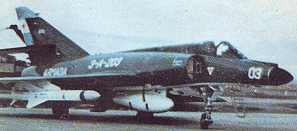
The Super Etendard in the picture is the
0753/3-A-203. It was flown by Warship Lieutenant Armando Mayora on May
4th, and used again by Corvette Captain Roberto Curilovic on May 25th 1982
against the MV Atlantic Conveyor. The photograph was taken a few minutes
before the beginning of the latter mission (you can see the AM.39 Exocet
under the right wing of the aircraft).
Curilovic and Barraza met
the KC-130H in the planned time and place, and after the refuelling, both
set their course to the South East, right to the target (at this time 480
kms away - 300 miles). When they were at 240 kms (150 miles) of the target
coordinates began to fly in at only 8 or 10 meters over the sea. Both
pilots found the target exactly where the radars had predicted (58º 38'
South, 56º 8' West), and they loaded the coordinates in the weapon system,
launched the Exocets at 16:31 hrs and turned back. After a second meeting
with the tanker, they returned to Río Grande at 18:38 hrs. It was the
longest range mission of the Super Etendard. They flew 2,592 kms (1,620
miles) during 3 hours and 50 minutes. According to British sources, the
Exocets hit the cargo ship MV Atlantic Conveyor at 16:36 hrs and the ship
caught fire and sank in a couple of hours. It was the greatest logistic
loss suffered by the British Task Force 317, because the Atlantic Conveyor
was carrying tents for 5,000 men, at least ten helicopters (three Chinooks
HC.1 of the 18th Sqdn. RAF, six Wessexs HU.5 of the 848th Sqdn. RN, and
one Lynx HAS.2 of the 815th Squadron RN), spare engines and pieces for the
Harriers, a plant to make sea water drinkable, and the materials to build
a mobile runway for the Sea Harriers. In the wreckage also 12 British
sailors were killed, including Ian North, the captain of the Atlantic
Conveyor.

The map shows the course of all the missions performed by
the Argentine Super Etendards, including the aborted mission on May 2nd
and the unsuccessful sortie on May 23rd. The date of each mission is
indicated next to the path, and the small pictures of ships indicate which
target was sunk/hit in each mission.
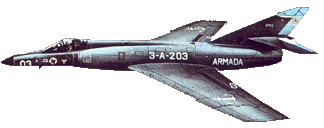
A drawing of the Super Etendard 0753/3-A-203 piloted
by Curilovic on May 25th 1982.
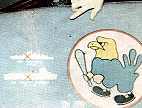
The unit's badge, nicknamed 'La Lora' ('The Female
Parrot'), though it actually represents a sparrow hawk armed with a stick.
The picture also shows the marked silhouettes of the ships that this plane
contributed to sink: the HMS Sheffield and the MV Atlantic Conveyor.

A photograph of Corvette Captain Roberto Curilovic
taken when he was descending from the cockpit of his Super Etendard after
the mission on May 25th.

This picture shows the aspect of the Atlantic Conveyor once the fire was
finally extinguished, and it was evident that the ship could not be saved.
While some sources assert that only one of the Exocets hit the cargo ship,
others affirm that both missiles hit and exploded. A great amount of
British military supplies sank with the ship, including three out of four
HC.4 Chinook helicopters of the 18th Sqdn. RAF and six HU.5 Wessexs of the
848th Sqdn. RN. The loss of these helicopters delayed the British
offensive against Puerto Argentino, the capital, and the main Argentine
garrison of the islands.
The attack
against the HMS Invincible
After the Atlantic
Conveyor wreckage, the Argentine Navy had only one Exocet left, and the
British carriers still were the main Argentine targets. For these reasons,
on May 29th the CANA and the FAA decided to perform a joint operation.
Four pilots of A-4C Skyhawk belonging to the Grupo 4 de Caza (4th Fighter
Group) received the assignment -actually two of them, 1st Lieutenants
Ernesto Ureta and José Vazquez, volunteered, and chose the other two
pilots, 1st Lieutenant Omar Castillo and Ensign Gerardo Isaac- and were
sent to Río Grande. The plan was that once the Super Etendards launched
the remaining Exocet, the Skyhawks followed the trail of the missile and
hit the carrier with their 227 kgs (500 pounds) bombs. Of course, the
A-4Cs would face the worst of the enemy defences.
About 12:30 hrs on May
30th 1982, two Super Etendards took off from Río Grande; the SUE
0752/3-A-202, piloted by the leader, Warship Lieutenant Alejandro
Francisco, took off first , and second was the SUE 0755/3-A-205, flown by
the wingman, Warship Lieutenant Luis Collavino. Five minutes later, the
A-4Cs, belonging to the Air Force, also took off. Francisco carried the
Exocet, and Collavino provided support and verification. The call signs of
the Super Etendards and Skyhawks were 'Ala' and 'Zonda' respectively.
All the planes climbed to
an altitude of 7,000 meters (21,000 feet) and flew to the rendezvous point
with the KC-130H, where all the fighters were resupplied with fuel for 300
kms. After this refueling the planes turned to the east, with both SUEs
separated by 1,600 meters (1 mile) and two Skyhawks behind each. When all
of them were at 304 kms (190 miles) from the target area, they dived to an
altitude of 30 meters (100 feet). Around 14:32 'Ala 1', Francisco,
reported they had locked the Exocet on the target. 'Ala 2', Collavino,
confirmed the lock and so Francisco launched the missile. With this
launch, the participation of the 2nd Air Naval Squadron in the war came to
an end. Both Super Etendards turned back and headed towards the meeting
point with the KC-130H, and after that arrived at Río Grande without
problems.
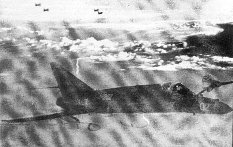
This historical photograph shows the SUE #
0752/3-A-202 piloted by Warship Lieutenant Alejandro Francisco when
refueling on its way to the target, HMS Invincible on May 30th 1982. The
last AM.39 Exocet can be seen under the right wing of the SUE, and the
four A-4C Skyhawks of the 4th Fighter Group of the Argentine Air Force can
also be seen far behind, waiting for their turn to refuel.
After the Exocet's
launching, the Air Force's Skyhawks followed the trail of the missile, and
watched the appearance of a thick smoke column on the horizon, an so they
headed for it. When they were at 12 kms (7.5 miles) a SAM destroyed
Vazquez's aircraft and so did another to Castillo's Skyhawk at 2 kms (1.25
miles) to the target. According to British sources, they were Sea Darts
launched by the destroyer HMS Exeter. Both pilots died. But the survivors,
Ureta and Isaac 'Zonda 3' and 'Zonda 4' respectively, reached the target,
dropped their bombs and fired all their gun's ammunition. After that, they
turned back, performed evasive maneuvers against the British SAMs and AAA,
and got out of the danger zone without damage. Both planes reached the
KC-130H and refuelled, arriving at Río Grande 3 hours and 47 minutes after
they had taken off. During the debriefing, both pilots described the
attacked target as a carrier, and specifically as the HMS Invincible.
Note: There is not an
official British version about the attack, but the theory exposed in the
book 'Falklands, the Air War' is the following: the ship attacked by Ureta
and Isaac was the frigate HMS Avenger, which was loosing white smoke as a
curtain, and its helicopter's flight deck was wrongly mistaken as the
flight deck of a carrier by the Argentine pilots. All the bombs of the
Skyhawks missed. The problem with this version is the fact that the smoke
seen by the Argentine pilots was not white, but black. It is also
ridiculous that well trained pilots as Ureta and Isaac could misidentify
the short deck of a frigate with the long and lateral one of a carrier. It
is also suspicious that the Invincible appeared at Port Stanley almost two
months after the attack, in August 1982 and when she returned to
Portsmouth on September 17th 1982, a big strip on the port side looked as
if it had been recently repainted.
The Argentine version said
that the last Exocet missile was perfectly locked-on to the target (a big
ship) by the Super Etendard pilot, who fired it and turned back to Río
Grande without troubles. The four A-4C Skyhawks of 4th Group followed the
trail of the missile and finally saw in the distance a big column of
black smoke, possibly the place where the missile impacted. Two of them
were shot down, but the survivors confirmed that they saw a carrier, and
specifically the HMS Invincible with a thick black smoke column coming
out of it. They attacked it, firing their cannons and dropping their
bombs, without confirming any results. After avoiding all the SAMs fired
against them, the Skyhawks met their tanker and returned home.
The British version of
this incident exposed that the Exocet failed its mark, the HMS Invincible,
due to it being downed by a 114 mm shell from the frigate HMS Avenger, or
due to it being neutralized by decoys. Additionally, they asserted that
the ship attacked by the A-4C Skyhawks was the HMS Avenger, which was
deploying a curtain of white smoke to hide the carrier from any attacker.
Many specialists said that the Argentine pilots misidentified the small
flight deck of the anti-submarine helicopter with the flight deck of the
carrier, and wrongly thought that the smoke of the curtain was cause by
the Exocet hit.
But from the Argentine
point of view, the problems with such versions are:
1) it is highly unlikely
that a 114 mm shell could actually destroy a sea-skimming missile flying
at 10 metres high at 1,000 km/h.
2) the decoys fully failed
only five days before, when the MV Atlantic Conveyor was sunk, and why
should they work that day?
3) the smoke seen by the
Argentine Skyhawk pilots was not white, but black.
4) Even in a stress
situation like being attacked with AAA and SAM fire, it is hard to mis-identify
the big, lateral flight deck of a carrier with the small helicopter flight
deck of a frigate.
5) Besides all that, HMS
Invincible did not appear in Port Stanley until late July 1982, and when
she returned to England in September 1982, it looked like a big stripe on
the port side (the side attacked by the Exocet and the Skyhawks) recently
painted.
All that made me think
that the carrier, HMS Invincible was actually hit that May 30 1982 (not
seriously hit, but hit at last) and we have good reason to think that. Of
course we could be wrong, but we truly and sincerely believe that.
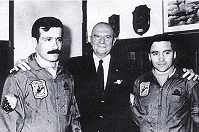
The A-4C Skyhawk pilots belonging to the 4th Fighter
Group, who survived the attack against the British carrier HMS Invincible,
were 1st Lt. Ernesto Rubén Ureta (Left) and Ensign Gerardo Guillermo Isaac
(Right). They are posing with WWII French Ace Pierre Clostermann (Centre).
Both pilots are completely sure that the ship which was hit by the Exocet,
and later attacked by them, was the Invincible.
|
